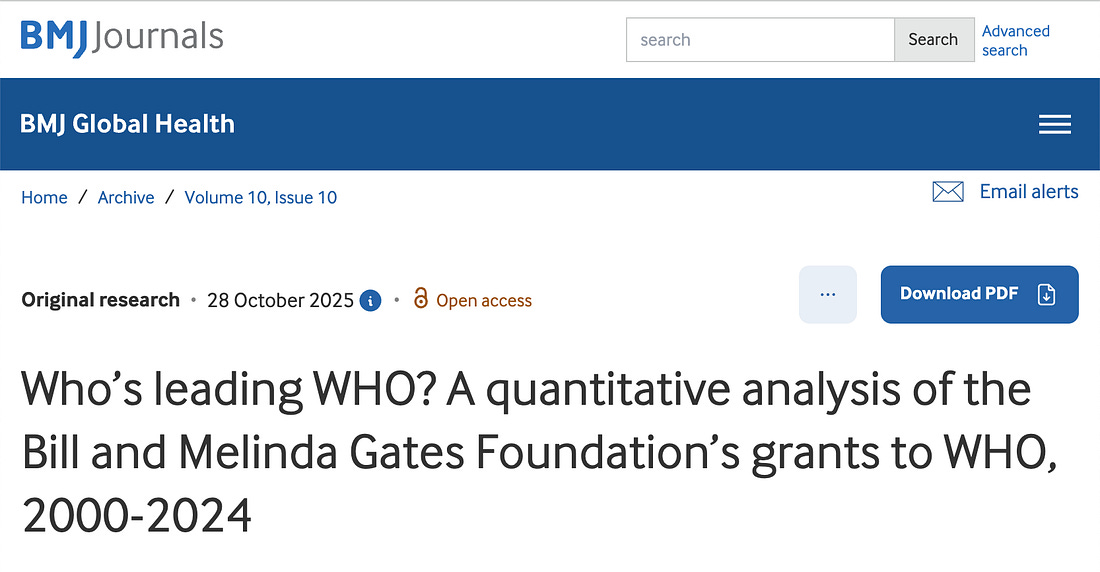Bill Gates, Polio and the WHO
Skewing of global health priorities by a rich man seeking absolution and immortality
| DR. ROBERT W. MALONE OCT 30 |

The British Medical Journal, otherwise known as BMJ, just published a peer-reviewed study titled “Who’s leading WHO? A quantitative analysis of the Bill and Melinda Gates Foundation’s grants to WHO, 2000-2024 (ref).” Note that the authors have no affiliation to BMJ, the WHO, or Bill Gates, but are academics centered in the UK.

The Bill and Melinda Gates Foundation (BMGF) ranks as the World Health Organization’s (WHO) second-largest funder, providing 9.5% of WHO’s income from 2010 to 2023. This study examines how BMGF funds allocated to the WHO are spent.
Out of all the contributions from BMGF to WHO, a significant $4.5 billion, which is 82.6%, was dedicated to infectious diseases. Of this, $3.2 billion (58.9%) specifically went toward polio, even though polio accounts for only a tiny part of the overall global disease burden.
Polio is an “interesting” target for a massive vaccine campaign because it is generally not spread through the respiratory tract, but instead is spread through the fecal-oral route. The virus is shed in the stool of an infected person (even if they have no symptoms). It can contaminate drinking water, food prepared with unwashed hands as well as surfaces and objects (especially in areas with poor sanitation). Although the Ro (baseline reproduction coefficient) for polio virus is typically listed in the 5-7 range (high), that is a historical number from when sanitation practices were much different and does not reflect the realities of polio in westernized nations today. In other words, it is outdated.
The decline of polio in Western countries is closely linked not only to vaccination efforts but also to significant advances in public sanitation, water infrastructure, and hygiene habits that started many years prior and progressed alongside the introduction of vaccines. So, if the WHO and BMGF really wanted to eradicate polio, they would spend more resources building sanitation infrastructure, including clean drinking water supplies, and better septic systems. This would also dovetail nicely into the WHO’s primary mission of improving global health.
Only a small fraction of the BMGF funding to the WHO truly contributed to strengthening healthcare worldwide, combating non-communicable diseases, and tackling broader health issues. These areas are essential to the WHO’s mission and to global health.
It’s worth considering the motives behind the global push to vaccinate against polio, especially since the actual Ro is low in Westernized countries. In countries with poor sanitation, improving sanitation may have a greater impact on reducing polio cases than simply aiming to vaccinate everyone. Sometimes, addressing the root causes can be just as important as the vaccines themselves. The historic major successes in public health do not involve vaccines; they involve sanitation.
The vast majority of outbreaks are now vaccine-derived polio. Let that sink in for a moment…
Furthermore, in 2024, 289 confirmed cases of polio caused paralysis worldwide (paralytic polio is what is reported to the WHO). This suggests that the actual number of polio infections could range from 30,000 to 300,000 (at the upper limit), as the vast majority of cases remain undetected. About 95% of polio is asymptomatic, and only 0.1–1 % is paralytic (clinical poliomyelitis). The truth is that polio is not the “killer” disease that the propagandists make it out to be.
In reality, there are somewhere between 3.75 polio infections per million people to 37.5 polio infections per million people. The vast majority of these are asymptomatic.
Going a step further with these calculations, there is 1 case per 27.7 million people worldwide of paralytic polio.
The Gates Foundation’s official Annual Report 2024, which lists “Polio — $889,000,000” under Total direct grantee support (Global Development).” This reflects grants made to partners (e.g., WHO/UNICEF/GPEI implementers) and excludes operating costs and program-related investments.
Bill Gates and his foundation invested $889 million in polio eradication efforts in 2024 alone. This means that for each of the 289 cases of paralytic polio, he spent approximately $3 million per person – the vast majority of that going into the arms of children. How could this be a good investment, given the state of global health and the fact that proper sanitation and clean water not only “cures” polio but also improve almost all aspects of global health?
During an October 2025 Q&A with Rotary International, Gates emphasized his unwavering dedication to eliminating polio. He shared, “It is critical that we finish the job on polio. Eradication is the only way to make sure that continuing challenges don’t mean an ongoing risk for children today and for generations to come.”
Thinking it through does not take a genius intellect. This is an impossible goal. The reason why is embedded in the text above. THE VAST MAJORITY OF POLIO CASES ARE NOW VACCINE DERIVED! That means that the live-attenuated vaccine is infecting people with both asymptomatic and paralytic polio.
Oh, but wait! Gates and his scientific stable of paid sycophants aren’t stupid – they would have an answer for that! One might foresee the day when he will convince the WHO and organizations like GAVI to go with mRNA or other non-live attenuated viral vaccines for polio. In fact, clinicaltrials.gov lists 289 trials when the search criteria for “polio RNA vaccine” are used. Now, many of these are other novel vaccines (not RNA-based), but one must wonder how many of these clinical trials are either funded by companies in which Bill Gates holds significant shares or by the BMGF?
One has to wonder… is this really about polio?
Finally, the truth is that the WHO no longer represents its member states, and needs to be relegated to the dustbin of history. From 1948 to the 1970s, the WHO was fully funded by member states. Then, from the 1990s to the 2000s, they started accepting contributions from private foundations, NGOs and Pharma. I have direct experience with a client developing an Ebola vaccine being subjected to a shakedown for donations by the then Director of the WHO. The WHO is deeply and notoriously corrupt.
By the 2010s, over 80% of the World Health Organization’s budget was funded through voluntary contributions, with a large portion allocated to specific programs. The list of WHO’s voluntary supporters has grown to include pharmaceutical companies, philanthropic foundations, and NGO groups such as the Gates Foundation, GAVI, PATH, and the Wellcome Trust.
In 2016, WHO established the WHO Foundation, a separate fundraising organization explicitly created to accept donations from corporations and wealthy individuals, formalizing what had previously been ad hoc private donations. This foundation can now receive contributions from entities that WHO itself could not directly accept due to conflict-of-interest policies.
This is unacceptable, and it is high time that other nations joined the USA in withdrawing from the WHO, as it has become riddled with conflicts of interest.
The image of a phoenix, rising out of the ashes of the old, comes to mind. The world must evolve and leave the past behind. Global health needs a new face, with bilateral agreements being front and center of that effort.

